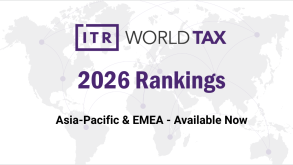The global pandemic is a human and economic catastrophe, but it may be more unique in its scale than its occurrence per se. Major disruptions to business operations are also regularly caused by natural disasters like earthquakes, floods, hurricanes (or its North West Pacific variety, the typhoon) and volcanic eruptions, as well as economic, demographic and geopolitical shifts. However, in the big picture, the COVID-19 crisis may end up being a marker between different eras of doing business internationally and a significantly different focus in managing the tax aspects.
Before the pandemic, 'agile' was the buzz word for businesses and now 'resilience' may appear to be the only game in town. In fact, one needs both, where, in the boxing analogy, agility is about being nimble on your feet to avoid blows and being quick to land one yourself, whereas resilience is about being well trained physically and mentally, so you can take a punch and recover fast. What does agility and resilience mean for the tax function?
Changing operating models
Since the 1990s, EY has had a dedicated tax practice to support multinational companies when they design and transform their operating models. In EY's global operating model effectiveness practice, many trends have already been seen in supply chain and organisation design, but at the end of the second decade of this millennium, many trends in society, politics and technology, are converging to create a perfect storm of change. Here, a tax perspective is provided on the developments.
A business model describes the way an enterprise earns money and is defined by the target market(s), the value proposition and its earnings model. The operating model describes how the enterprise delivers its business model. An operating model consists of multiple layers, as follows:
Processes and activities;
Organisation structure and locations;
Transactions and logistics network; and
Legal structure and tax framework.
The operating model follows from the strategic choices and serves a specific business model. Operating models can be improved while serving the same business model or change when companies transform their business models.
There are many important trends of change, including politically and economically, but there are a few major shifts in Asian operating models that are most relevant for taxation.
Supply chains were increasingly globalised, e.g. with cheap sourcing in Asia and sales in the US and EU or with Chinese companies sourcing raw materials in South America, Africa and Australia. At present, there are many pressures towards more regionalised or even localised sourcing, e.g. due to increased tariffs on cross-border trade or the desire to lower the carbon footprint of logistics.
Operating models for many industries were centralised and activities were internalised to achieve economies of scale, e.g. through centralised procurement and supply chain planning. Moreover, they consisted of a clear linear sequence of value-adding activities and logistics steps between suppliers and customers. Due to the diversity of markets and increasing uncertainties, companies need to become more agile and resilient, and want to build more flexibility into their supply chains. Therefore, the linear supply chain is evolving into a non-linear network that consists of related and un-related parties.
Centralised operating models could often fit into clean and straightforward tax and legal structures. Many multinationals deployed principal companies that manage the supply chain from a central (hub) location. Such principals are enabled by the capabilities of enterprise-wide systems and they usually co-locate various departments to achieve better coordination between them.
The evolution of the enterprise-wide systems and the introduction of technologies have led to innovative functions such as data analytics. Moreover, there is less need for co-location of personnel as many management teams work remotely from different locations. As a result, the one hub model has become untenable for many companies and value driving functions are often spread over different geographies and legal entities.
The new meaning of tax effectiveness
Before discussing what tax effectiveness means in the context of an operating model, it needs to be recognised that the performance measurement of tax departments in general has been evolving in the past decade. From a very singular measure like the effective tax rate, a broader set with tax risk management, (cost effectiveness of) compliance, tax reporting and tax policy development is increasingly common in many multinationals.
When designing and managing a company's operating model, the following main categories of tax measures are typically targeted:
A sustainable effective tax rate on operating income, e.g. by obtaining incentives based on functional substance and investments;
Maximum after tax cash flow and minimum landed cost through indirect tax optimisation, e.g. by using bonded warehouses and the application of free trade agreements;
Reducing controversy risk, e.g. by obtaining approvals from authorities up-front; and
Reducing administrative effort, e.g. by simplifying and automating tax processes.
A first observation is that the above tax aspects are often mutually dependent, for example when a higher transfer price could lower profit in a high tax market jurisdiction but would also increase the customs valuation upon importation.
Second, important changes do not only come from the external business factors described above but also from the regulatory tax framework itself. Since the 2008 global financial crisis, the base erosion and profit shifting (BEPS) project by the OECD and G20 has re-written the rules of international taxation and is still ongoing.
The effective tax rate (ETR) on income will remain a very important criterion as it typically is one of the highest individual cost items in a company's profit and loss account. There are four reasons why managing the ETR has become more complex, as discussed below.
Firstly, in the wake of BEPS, many more countries have introduced updated general anti-avoidance rules (GAARs) and controlled foreign corporation (CFC) rules or sharpened existing ones. The second wave of BEPS may yet bring more rules that target no or low-taxed earnings. As before, a company that organises its business based on real functional substance and that allocates taxable profits at arm's-length should not have much to fear, but the growing complexity and rule overkill can even catch the innocent.
Secondly, when the centralised operating models, built around a principal company, give way to more decentralised networks, tax departments can no longer make 'one deal of a lifetime' in the form of an incentive for the principal company. Instead, incentives for many different activities, e.g. high-tech manufacturing or research and development, in many different locations may have to be negotiated and maintained.
Thirdly, taxation is also becoming a matter of public opinion, as seen with the uproar about several advantageous tax rulings in the EU and more recently, regarding the COVID-19 tax relief measures and whether they are distributed fairly. A company needs to consider its reputation and technical arguments alone cannot always placate public opinion. For example, a location choice for new operations needs to consider perceptions about the jurisdiction as much as the hard facts.
Finally, ETR is a financial measure directly linked to shareholder value and companies are increasingly focusing on multiple stakeholders in addition to their shareholders, e.g. their customers, their employees, their suppliers, the environment, governments, etc.
All this means that managing the ETR requires integrating many technical tax, as well as other, considerations, and strong communication to the different stakeholders.
The evolution of transfer pricing
In addition to the level of taxation, transfer pricing, which is effectively the allocation of taxable profit within the multinational, is a major area of the tax department's attention and public concern. At present, the second wave of BEPS may set aside traditional frameworks of international taxation like that of permanent establishments and/or the arm's-length principle for transfer pricing. In transfer pricing, the following key changes are occurring.
Tax controversy about transfer pricing or simply failings in managing the transfer pricing are more often due to issues in the day-to-day processes and systems than about selection of the pricing method or quality of documentation. How prices are set, e.g. based on budget vs. actual, how often they are revised, e.g. monthly based on re-forecasted numbers vs. once at the end of the year based on actuals, and how the changes are executed, e.g. through specific credit/debit notes vs. lump-sum corrections, all determine the success. Operationalising the transfer pricing is the first line of defence and should get more attention, as well as resources, in the form of systems design and specific applications.
Servitisation and data analytics are changing the nature of inter-company transactions and what drives value within a multinational. For this discussion, 3D printing can be included as an extreme form of servitisation, where instead of making a product and moving it along the supply chain, a company may be selling the customer a set of electronic instructions to print a product at the customer's site. Services transactions require different legal arrangements than physical goods and the value of services is often more determined by intangible factors like training, methods and know-how, as well as employee motivation.
Data is often called the most valuable raw material, but value can only be derived by determining the right purpose, the data collection strategy, analytical methods and tools and finally by deciding how to put insights to good use. Today, many companies already actively manage such data value chains with important inter-company transactions whereby companies share data and/or provide analytics services.
Services and data can be dealt with and be incorporated in the existing analytical frameworks of transfer pricing and documentation but will need special attention and explanation when dealing with the tax authorities.
With the decline of straightforward and sequential supply chains and the emergence of dispersed value creating networks, the scope for applying the, still preferred, so-called traditional transaction methods, i.e. the comparable uncontrolled price, re-sale minus and cost-plus methods for transfer pricing will be reduced. For the operating models, 'special', in the sense of exceptional, methods like profit splits and cost contribution arrangements (CCA) are more suitable.
Over the past decade, it has been found that almost all countries acknowledge the profit split and the CCA in their legal and regulatory frameworks, but that the practical application, for direct tax, as well as indirect tax and foreign exchange rules etc., is far from easy and differs per country. Nevertheless, these methods are simply the right ones for many modern operating models and application will become easier as experience grows.
Changing tax department roles and organisation
With all the changes described above, it will be near impossible to be effective for a tax department if its role is narrowly defined as being responsible for direct taxation only, i.e. ETR, planning and income tax compliance. The many interdependencies between transfer pricing and indirect taxation, VAT/goods and services tax (GST) and customs and trade, require that these sit under one roof with the direct tax responsibilities.
Keeping an operating model tax effective or designing a new one also requires coordination and cooperation with many other stakeholders and departments outside the broader finance function, where tax typically resides, like legal, operations, logistics, investor relations, communications, etc. The department may require different skillsets, in addition to tax technical knowledge, for example, project management, supply chain transformation and digital expertise.
For all this to be possible, tax departments may have to create resource availability by streamlining tax compliance efforts, e.g. through automation, or by outsourcing compliance operations.
From discussions with clients, it has been realised that to keep operating models fit for purpose and to be able to deliver the promises of operational efficiency and tax effectiveness, companies rely on a role that only some have set up formally. That role is earmarked for the chief operating model officer (COMO). It may be a dedicated function at the C-level or could be a shared role carried by senior executive functions.
Some multinationals have COMO-type roles in their tax departments, as a lot of the design layers come together and need to be properly understood for tax purposes, e.g. how strategy determines value drivers and how these are managed through processes, etc., all the way to how that all translates to transfer pricing between legal entities. COMO or not, a modern tax department in a multinational with a complex and evolving operating model will need full dedication and the right resources for its challenging tasks.
Click here to read the entire 2020 EY-ITR Asia Pacific Guide
Paul Griffiths Partner T: +65 6309 8068 Paul Griffiths is a partner in the operating model effectiveness (OME) team of the Asia-Pacific tax centre, based in Singapore. He has 20 years' experience in transfer pricing and business restructuring, and has previously worked for the firm in London and Melbourne. He has managed a wide range of OME and transfer pricing engagements covering issues such as supply chain re-organisation, intellectual property, procurement, transfer pricing design and post-acquisition integration. He has worked on client engagements across a broad range of industries, including automotive, consumer products, telecommunications, pharmaceutical and healthcare, industrial products, energy and business services. Paul has a bachelor's and a master's degree in economics from the University of Exeter. |
Edvard Rinck Partner T: +852 2846 9888 Edvard Rinck is partner in the OME team of the Asia-Pacific tax centre, based in Hong Kong SAR. He has 28 years of experience working in multinationals and as a consultant. In 2000 he joined the OME practice and subsequently worked in the Netherlands, the US, Switzerland, Singapore and Hong Kong SAR. Over the years, he has worked on a large number OME engagements as a work stream leader, project manager and engagement leader. He has advised US, European and Asian multinational companies regarding the establishment of regional as well as global supply chain management structures, around different headquarter locations. Edvard holds degrees from Nijenrode University and Erasmus University in the Netherlands. |













